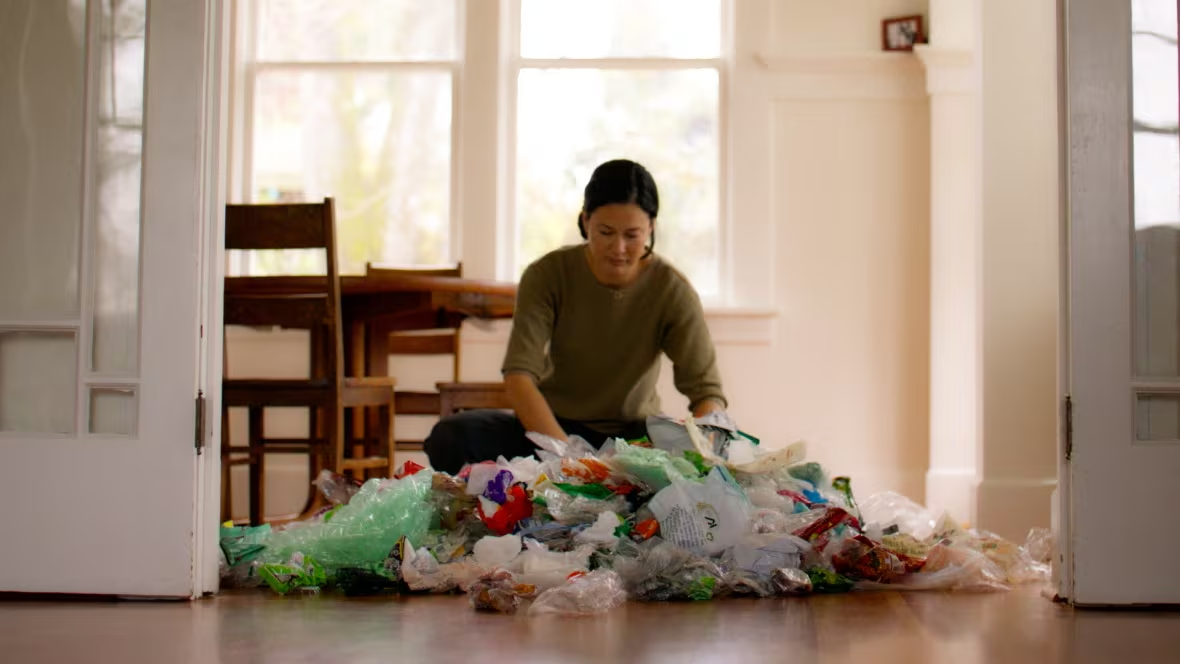I thought my body was safe from microplastics. I was wrong

Nothing will radicalize you how to see the trash of another person in your body.
In my blood, in my lungs and in my courage, there are small invisible particles of plastic bags, medical waste, tire powder, synthetic clothing and food packaging.
Make the movie Plastic people He made me understand that I am a human landfill.
In the documentary, from The nature of thingsI have my home, food and body tested for microplastics as part of an investigation into our addiction to plastic and on the growing threat to human health.
I started the journey thinking that my body was relatively uncontaminated.
Like Eco-Enerd in good faith, I thought there could not be so much plastic in my house. My carpet and my sofa are made of natural fibers; I don’t eat a lot of fast food; I even use Beeswax windings for my leftovers.
And that’s why, when we started discussing ideas for the film, I thought I would have to try to weigh my body extra Plastic – eating crustaceans, for example, which I normally do not do – to see if we could detect a peak in my system.
It turns out that it was not necessary. My body was already flooded.
When we destroy the environment, inevitably also our bodies
While science is new, studies on microplastics in the human body are revealing how insidious the tiny toxic particles are.
A recent study Looking at the human brain, for example, it was discovered that we could have everywhere from five to seven grams of plastic housed between our ears (even if the experts I have spoken with have suggested that the actual number is not so high). Seven grams of plastic – the high end of the esteem – is approximately the weight of a spoonful of US plastic.
It is an appropriate image if you consider that around 40 billion plastic tools are used and thrown every year only in the United States. And that plastic does not disappear. It breaks in small pieces that sweep in our oceans, they are buried in the ground and move in the air.
We breathe that plastic. We eat that plastic. We drink that plastic (about 80 % of tap water contain microplastics).
So it should not surprise the fact that when we transform the environment, we inevitably also transform our bodies. However, reading microplastics in titles is one thing, but See That garbage in your body is rather another.
We are becoming plastic people
For the documentary, I traveled all over the world and met scientists to test the microplastic burden in my body.
I will spare you the bloody details of having to test my feces (very not glamorous), but they were the microplastics in my blood that I found more shocking. My samples have been tested as part of a double blind study. In the film, the researchers were finding an average of 11 microplastic particles in 2.5 milliliters of blood – the equivalent of half a teaspoon.
Now, keep in mind that the average adult has about five liters of blood in their body. If only 2.5 milliliters contains 11 microplastic particles, make mathematics and consider how garbage it is scrolling through your body. We are literally becoming plastic people.
Ziya Tong participated in a double -blind study that tested microplasty in the blood of the donors. In the plastic documentary, the researchers found microplastics in each 2.5 milliliters’ blood sample, the equivalent of half a teaspoon. Look at plastic people on CBC Gem and the nature of the things that YouTube Channel.
Can we stop plastic pollution?
The fact is that while plastic is omnipresent, most of us do not yet see it in our surroundings. This is because so much plastic is invisible and it is hiding where you would less expect it: in paint, floors, paper glasses, clothes, chewing rubber, cigarette butts, makeup, sunscreen – it is also in our product stickers.
Needless to say, the campaigns that focus exclusively on prohibiting plastic straws or bags are missing.

This leads us to the question that I am most often asked: what can be done to stop plastic pollution?
The good news is that there are some very intelligent and dedicated people who work to ban disposable plastic. At this moment, the Treaty of global plastic Negotiations are taking place, with 170 countries working on a legal framework to stop plastic pollution. There is also growth Corporate coalitionwhich is working on systemic change and a circular economy.
There are Community without plastic all over the world, where residents are fighting against disposable plastic and in Plastic peopleWe deepen new technologies and alternatives of plastic. So there is absolutely hope and there are solutions.
The first step to solve a big problem is to identify and name it. Ten years ago, few people even knew that the problem of microplastics existed. Today, the tiny and invisible threat is making news on the front page.
The key thing to remember is that we know how to solve big problems. Just as the DDT was gradually eliminated in the 70s after understanding its damage, if we work together to ban disposable plastic now, we will reduce the harmful effects of microplastics on the planetary body and, above all, also on the human body.
Clock Plastic people ON Gem CBC and the YouTube channel DOCS CBC.





